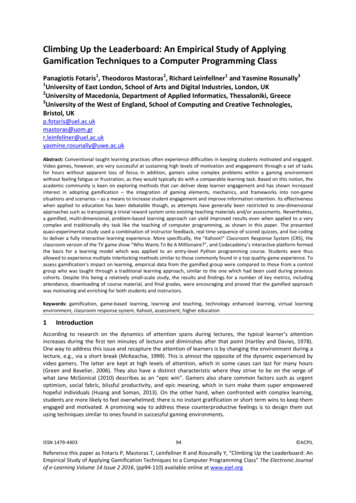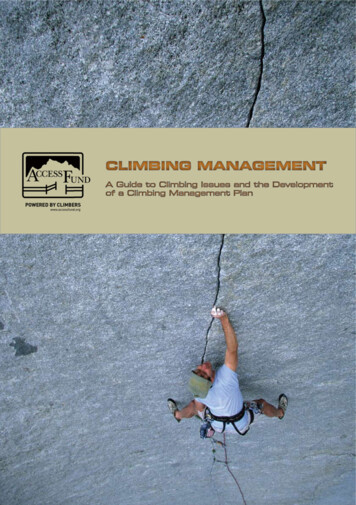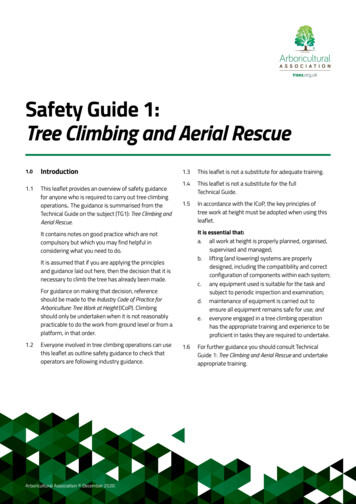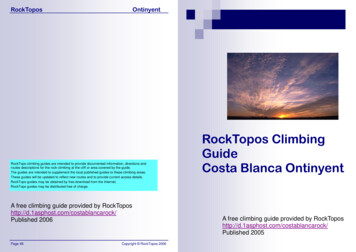
Transcription
Climbing Up the Leaderboard: An Empirical Study of ApplyingGamification Techniques to a Computer Programming ClassPanagiotis Fotaris1, Theodoros Mastoras2, Richard Leinfellner1 and Yasmine Rosunally31University of East London, School of Arts and Digital Industries, London, UK2University of Macedonia, Department of Applied Informatics, Thessaloniki, Greece3University of the West of England, School of Computing and Creative Technologies,Bristol, uel.ac.ukyasmine.rosunally@uwe.ac.ukAbstract: Conventional taught learning practices often experience difficulties in keeping students motivated and engaged.Video games, however, are very successful at sustaining high levels of motivation and engagement through a set of tasksfor hours without apparent loss of focus. In addition, gamers solve complex problems within a gaming environmentwithout feeling fatigue or frustration, as they would typically do with a comparable learning task. Based on this notion, theacademic community is keen on exploring methods that can deliver deep learner engagement and has shown increasedinterest in adopting gamification – the integration of gaming elements, mechanics, and frameworks into non-gamesituations and scenarios – as a means to increase student engagement and improve information retention. Its effectivenesswhen applied to education has been debatable though, as attempts have generally been restricted to one-dimensionalapproaches such as transposing a trivial reward system onto existing teaching materials and/or assessments. Nevertheless,a gamified, multi-dimensional, problem-based learning approach can yield improved results even when applied to a verycomplex and traditionally dry task like the teaching of computer programming, as shown in this paper. The presentedquasi-experimental study used a combination of instructor feedback, real time sequence of scored quizzes, and live codingto deliver a fully interactive learning experience. More specifically, the “Kahoot!” Classroom Response System (CRS), theclassroom version of the TV game show “Who Wants To Be A Millionaire?”, and Codecademy’s interactive platform formedthe basis for a learning model which was applied to an entry-level Python programming course. Students were thusallowed to experience multiple interlocking methods similar to those commonly found in a top quality game experience. Toassess gamification’s impact on learning, empirical data from the gamified group were compared to those from a controlgroup who was taught through a traditional learning approach, similar to the one which had been used during previouscohorts. Despite this being a relatively small-scale study, the results and findings for a number of key metrics, includingattendance, downloading of course material, and final grades, were encouraging and proved that the gamified approachwas motivating and enriching for both students and instructors.Keywords: gamification, game-based learning, learning and teaching, technology enhanced learning, virtual learningenvironment, classroom response system, Kahoot, assessment, higher education1IntroductionAccording to research on the dynamics of attention spans during lectures, the typical learner’s attentionincreases during the first ten minutes of lecture and diminishes after that point (Hartley and Davies, 1978).One way to address this issue and recapture the attention of learners is by changing the environment during alecture, e.g., via a short break (McKeachie, 1999). This is almost the opposite of the dynamic experienced byvideo gamers. The latter are kept at high levels of attention, which in some cases can last for many hours(Green and Bavelier, 2006). They also have a distinct characteristic where they strive to be on the verge ofwhat Jane McGonical (2010) describes as an “epic win”. Gamers also share common factors such as urgentoptimism, social fabric, blissful productivity, and epic meaning, which in turn make them super empoweredhopeful individuals (Huang and Soman, 2013). On the other hand, when confronted with complex learning,students are more likely to feel overwhelmed; there is no instant gratification or short term wins to keep themengaged and motivated. A promising way to address these counterproductive feelings is to design them outusing techniques similar to ones found in successful gaming environments.ISSN 1479-440394 ACPILReference this paper as Fotaris P, Mastoras T, Leinfellner R and Rosunally Y, “Climbing Up the Leaderboard: AnEmpirical Study of Applying Gamification Techniques to a Computer Programming Class” The Electronic Journalof e-Learning Volume 14 Issue 2 2016, (pp94-110) available online at www.ejel.org
Panagiotis Fotaris et alRather than assuming that the rapid proliferation of sophisticated technologies such as smartphones, tablets,and laptop computers into every facet of society is the cause of student attention deficit (Griffin, 2014),educators should be open to new possibilities to teach and educate (Squire, 2003; de Aguilera and Mendiz,2003). Findings of independent experiments performed in secondary and higher education settings showedthat students who were subjects to learning with video games reported significant improvements in subjectunderstanding, diligence, and motivation (Barata et al., 2013; Coller and Shernoff, 2009; Kebritchi et al., 2008;Lee et al., 2004; McClean et al., 2001; Squire et al., 2004).In the same way that games help stimulate the production of dopamine, a chemical that is considered to play akey role in motivation, affect and learning (Wimmer et al., 2014), educational techniques which access thesame methodologies could result in learning-reward cycles (Gee, 2003) by reinforcing neuronal connectionsand communications during learning activity (NMC Horizon Report, 2013). Additionally, unlike the one-sizefits-all lecture, these game-based techniques can be balanced to be appropriate to the learners’ skill level(Koster, 2004) in order to prevent them from becoming frustrated or bored, thus allowing them to experience“flow”, i.e., a user’s state of “optimal experience” (Barata, 2013; Chen, 2007; Csikszentmihalyi, 1990).Gamification for learning should use game mechanics, dynamics, and frameworks to non-game processesalong the following principles, which were adapted from Self-Determination Theory (Ryan and Deci, 2000): Relatedness – the universal need to interact and be connected with others; Competence – the universal need to be effective and master a problem in a given environment; Autonomy – the universal need to control one’s own life.These elements have been shown to affect intrinsic and extrinsic motivation, which in turn can have a bigimpact on student engagement and motivation (Deterding et al., 2011). Intrinsic motivation (e.g., altruism,competition, cooperation, sense of belonging, love or aggression) is driven by an interest or enjoyment in thetask itself and inspires people to initiate an activity for its own sake (Ryan and Deci, 2000). Students who areintrinsically motivated are more likely to engage in a task willingly, as well as work to improve their skills,which will increase their capabilities (Wigfield et al., 2004). In contrast, extrinsic motivation comes fromoutside the individual and refers to the performance of an activity in order to attain an outcome (e.g., earngrades, levels, points, badges, awards) or to avoid punishment (Muntean, 2011). Typical extrinsic incentivesinclude competitions, cheering crowds, and desire to win trophies.Individual student fatigue could be taken into account so as to determine the optimal combination of intrinsicand extrinsic motivators; this would automatically re-captivate students and provide a rewarding breakwithout producing any detrimental effects. By introducing game mechanics into generally unpopular activitiessuch as assessments, students would enjoy the tasks first and, in the process of completing them, they woulddeliver the required assessment.However, despite the fact that gamification of education is gaining support among an increasing number ofacademics who recognise that effectively designed games can stimulate large gains in productivity andcreativity among learners (NMC Horizon Report, 2014), opponents argue that what is lacking is concreteempirical data to support or refute these theoretical claims (Annetta et al., 2009; Barata et al., 2013). Some ofthe negative experiences include disappearance of collaboration among students and overstimulation ofcompetitiveness. The balance between learning, social collaboration, creativity, and competitiveness which isapparent in mainstream commercial games seems to be hard to achieve in tools specifically designed foreducation (Zaha et al., 2014). As a result, gamification is often reduced into a behaviour model leveraginghuman need for positive reward system and instant gratification, which is applied to a traditional teachercentred classroom.Annetta et al. (2009) and Britain and Liber (2004) suggest that both teachers and researchers need to evaluatevideo games and gamification from an educational perspective, in order to determine whether they can beembedded into teaching practices. Based on this notion, the present paper aspires to make a contribution tothe empirical evidence in the gamification field by designing, implementing and evaluating a gamified learningexperience in a higher education setting. This research effort tries to bridge the gap between theory andpractice, as well as to study the educational impact of gamification in a real educational setting. The specificresearch questions were:www.ejel.org95ISSN 1479-439X
The Electronic Journal of e-Learning Volume 14 Issue 2 2016 Are students who use Codecademy and play “Who Wants To Be A Millionaire?” and “Kahoot!” moreengaged in learning Python programming when compared to peers who engage in traditional classactivities? Do students who use Codecademy and play “Who Wants To Be A Millionaire?” and “Kahoot!” developdeeper understandings of Python programming when compared to peers engaged in more traditionalinstruction?2Related worksThe idea of using gamification for learning is not entirely new. In the 1980s Malone (1980; 1981; 1982) didresearch on what makes video games attractive to players and how these aspects can be applied to educationas a means to promote student engagement and motivation. Carroll (1982) analysed the design of the seminaltext adventure “Adventure”, which in turn led him to propose redressing routine work activities in varying“metaphoric cover stories” in order to turn them into something more intrinsically interesting, and to “urge fora research program on fun and its relation to ease of use” (Deterding et al., 2011; Carroll and Thomas, 1982).The new millennium saw the introduction of the terms “ludic engagement”, “ludic design”, and “ludicactivities” to describe “activities motivated by curiosity, exploration, and reflection” (Gaver et al., 2004), aswell as the emergence of a new field called “’funology’ – the science of enjoyable technology” (Blythe et al.,2004) which was inspired by game design and studied “hedonic attributes” (Hassenzahl, 2003) or“motivational affordances” (Zhang, 2008) of “pleasurable products” (Jordan, 2002). Related research focusedon using game interfaces and controllers in other contexts (Chao, 2001), creating “games with a purpose” inwhich game play is employed to solve human information tasks (e.g., tagging images) (Ahn and Dabbish, 2008),and exploring “playfulness” as a desirable user experience or mode of interaction.The use of video games for educational purposes was also emphasized by the works of Prensky (2001) and Gee(2003). Although these studies were related to game-based learning rather than gamification, their findingsform the core of gamification in education: they described the influence of game play on cognitivedevelopment, identified 36 learning principles found in video games, and recognised potential advantages ofvideo games in learning such as the value of immediate feedback, self-regulated learning, information ondemand, team collaboration, and motivating cycles of expertise (Borys and Laskowski, 2013).More recently, major corporations and organisations including Adobe (LevelUp, Jigsaw - Dong et al., 2012),Microsoft (Ribbon Hero), IBM (SimArchitect - IBM Global Business Services, 2012), and Autodesk (GamiCAD - Liet al., 2012) consulted with game experts to develop gamified systems that focus on keeping users engagedwhile learning new software and techniques. Other successful cases of gamification in education include KhanAcademy, Treehouse, Udemy, and Duolingo, organisations that provide access to a rich library of content(including interactive challenges, assessments and videos on several subjects) and use badges and points tokeep track of student progress. Codeacademy is an e-learning platform specialised for computer programming,designed with gamification in mind, while Kahoot is an example of a popular game-based Classroom ResponseSystem (CRS, also commonly known as “clicker”) (Fies and Marshall, 2006) that can be played on any devicewith a browser, both in online and traditional learning environments.In the context of higher and secondary education, gamification can be applied at vastly different scales to anydiscipline. At one end is gamification at the micro-scale: individual teachers who gamify their own classstructures (Lee and Hammer, 2011) such as Lee Sheldon (2011), a professor at Rensselaer Polytechnic Institutewho turned a conventional learning experience into a game without resorting to technology by discardingtraditional grading and replacing it with earning “experience points”, while also converting homeworkassignments into quests (Laster, 2010). At the other end of the scale, a charter school in New York City called“Quest to Learn” uses game design as its organising framework for teaching and learning. Teachers collaboratewith game designers to develop playful curricula and base the entire school day around game elements(Corbett, 2010).To summarise, although the amount of literature on gamification in education is constantly increasing, thewide range of course types, learning preferences, student backgrounds, and socio-economical environmentsrequires more systematic studies of the influence of different gamification techniques in order to assess theirefficiency (Barata et al., 2013).www.ejel.org96 ACPIL
Panagiotis Fotaris et al33.1MethodologyStudy design and sampleTeaching and assessment of computer programming is considered to be difficult and frequently ineffective,especially to weaker students, as computer programs and algorithms are abstract and complex entities thatinvolve concepts and processes which are often found hard to teach and learn (Olsson et al., 2015; Lahtinen etal., 2005). This sometimes results in undesirable outcomes such as disengagement, cheating, learnedhelplessness, and dropping out (Robins et al., 2003; Winslow, 1996). Furthermore, most students would notdescribe classroom-based activities in school as playful experiences. However, research on multimodalteaching has shown that adding more channels for the knowledge transfer can facilitate learning in general(Olsson et al., 2015). Based on this fact and the concepts of the increasingly popular gamification, game-basedlearning, and serious games movements, the present paper evaluates how gamification affected students of a12-week university course named “Fundamentals of Software Development” (FSD) via the use of the “Kahoot!”CRS, a modified classroom version of the TV game show “Who Wants To Be A Millionaire?” (WWTBAM), andCodecademy’s online interactive platform.To reach this objective faculty staff composed of three lecturers conducted a quasi-experimental study overtwo consecutive academic years at the School of Computing and Technology, University of West London. Thesample included a control class (CC) of Ncon 54 students (43 males, 11 females) who attended the FSD coursein the first year of the study, and an experimental class (EC) of Nexp 52 students (44 males, 8 females) whoattended FSD in the second year. The participants ranged from 19 to 25 years of age. Additionally, 16 studentsof the experimental group were regular gamers (31%), 28 played games occasionally (54%), and 8 did not playvideo games at all (15%).During the first year FSD followed a non-gamified approach that was similar to the one used in previous years.The syllabus included 12 regular one-hour lectures, 12 two-hour laboratory classes, and 12 one-hour seminars.The theoretical lectures covered Python programming concepts ranging from loops, functions, and objectoriented programming, to GUI applications and videogame development. In laboratory classes students werepresented with a series of programming tasks that they had to complete individually during the session, withthe tutors offering occasional help. Finally, seminars were used for revision purposes and were delivered via acombination of Q A and typical lectures. All course materials were uploaded to the institutional VirtualLearning Environment (Blackboard) on a weekly basis. The course evaluation consisted of 6 theoretical quizzes(30% of total grade) and 2 mandatory assessments: a final exam (35%) and a programming project (35%).An analysis of the student performance data at the end of the first year showed low attendance rates,numerous late arrivals to classes, and lack of interest in the reference material (low number of downloads thatincreased only before the exams period). In order to address these issues and to make FSD more fun andengaging, teaching methods changed in the second year to incorporate gamification. Literature indicates thateducational gameplay fosters engagement in critical thinking, creative problem solving, and teamwork (NMCHorizon Report, 2014). When students are actively engaged in the content that they are learning, there isincreased motivation, transfer of new information, and retention (Premkumar and Coupal, 2008). Additionally,the attention span of students diminishes after the first 15-20 minutes into a lecture (Middendorf & andKalish, 1996). Based on these facts, while the course evaluation remained the same, the delivery of the coursewas gamified as follows.3.23.2.1Gamification of the courseFormative assessment using Kahoot!The initial one-hour theoretical lectures were replaced by three 20-minute cycles of a micro-lecture, aformative assessment in the form of a Kahoot! game, and a brief discussion. As mentioned earlier, Kahoot! is aweb-based CRS (Hwang et al., 2015) that uses colourful graphics and audio to temporarily transform aclassroom into a game show, with the instructor acting as the show host and the students being thecompetitors. Every week the instructor created three Kahoot! games based on the topics that were going to becovered in the three micro-lectures of the upcoming class. After a micro-lecture was completed, the instructorlaunched its related Kahoot! game, which in turn generated a unique game pin for each session. Students thenwww.ejel.org97ISSN 1479-439X
The Electronic Journal of e-Learning Volume 14 Issue 2 2016used their own digital devices (tablets, smartphones, laptops) or the class desktops to log-in to the game, enterthe game pin, and create a username that would be displayed as the game progressed. Once everyone hadjoined the game, the instructor’s computer, which was connected to a large screen, displayed a set of 5 MCQsfor students to answer on their devices. Each answer was transmitted to Kahoot!’s online processing unit(server) which analysed it and rewarded students with points according to their accuracy and response time(Figure 1). Between each question Kahoot! showed a distribution chart of the students’ answers, thus allowingthe instructor to receive immediate feedback on whether concepts had been understood by the whole class orrequired further elaboration; in the latter case, he paused the game and offered any required explanations.Consequently, a scoreboard revealed the nicknames and scores of the top five responders, and at the end ofthe game a winner was announced and received some candy as a reward.Figure 1: “Kahoot!” in-game screenshotFollowing the game’s completion, the instructor discussed briefly all answers to each question anddownloaded a spreadsheet of the results in order to get an overview of the individual student and overall classperformance. Each student’s score was updated every week and was entered to a leaderboard webpage,which was publically accessible through Blackboard and displayed enrolled students in descending orderaccording to their total points. This visual display of progress and ranking provided students with directfeedback on their performance against both their own goals and the performance of their peers, while alsoserving as instant gratification. The thinking behind this decision was that rankings tap into people’s naturalcompetitiveness and encourage them to do better, which might motivate students to study more by the desireto improve their position (Natvig et al., 2004).3.2.2Collaborative problem solving with “Who Wants To Be A Millionaire?”The one-hour revision seminar was also changed; the combination of Q A and lectures that took place duringthe first year was replaced by an open-source implementation of WWTBAM, a television quiz show that offersa top prize of 1 million for answering correctly successive MC questions of increasing difficulty (Figure 2).Figure 2: “Who Wants To Be A Millionaire?” in-game screenshotwww.ejel.org98 ACPIL
Panagiotis Fotaris et alFigure 3: A sample question fileThe version of the game used in the classroom featured 540 Python-related MC questions (3 sets of 15questions per week), which were created by the instructors through a straightforward process that requiredthe editing of a simple text file (Figure 3).For logistic purposes the class was randomly divided into four groups of 13 students (11 male, 2 female) whoattended a separate seminar every week for a total of 12 weeks. During the first seminar each group wasrandomly split into three teams of 4-5 contestants that remained the same for the duration of the course, andthen the gaming activity started as outlined below.Each team was seated in front of the class facing the screen with their backs to the audience so that they couldnot receive any unsolicited assistance. Students were then asked 15 increasingly difficult questions on Pythonprogramming which covered a different topic every week. Since some of these questions were also scheduledto appear in the 6 theoretical quizzes, in fairness to the team of student contestants, all other students in theclass were instructed to put away their note-taking materials for the duration of the game. This also enhancedthe perception that the class was taking a break.Although there was no official time limit to answer a question, each game’s duration was limited to 20 minutesin order to give all teams the opportunity to play once during the seminar. Questions were multiple-choice: 4possible answers were given and the team had to collaborate, reach a consensus, and give a single response.Additionally, at the beginning of each game contestants were presented with an aid of three lifelines: Poll The Class: All students provided their answers for a particular question by raising their hands and thepercentage of each specific option as chosen by the class was displayed to the contestants. 50/50: The game eliminated two incorrect answers, thus leaving contestants with one incorrect and thecorrect answer to choose from. Ask A Friend: Contestants had 30 seconds to read the question and answer choices to a non-teamclassmate, who in turn had the remaining time to offer input.After viewing a question, the team could respond in one of three ways: Refuse to answer the question, quit the game, and retain all points earned up to that point. Answer the question and, if their answer was correct, earn points and continue to play, or lose all pointsearned to that point and end the game if incorrect. However, the 5,000 and 100,000 prizes wereguaranteed: if a team got a question wrong above these levels, then the prize dropped to the previousguaranteed prize. Use a lifeline (Ask A Friend, Poll The Class, or 50/50).www.ejel.org99ISSN 1479-439X
The Electronic Journal of e-Learning Volume 14 Issue 2 2016The game ended when the contestants answered a question incorrectly, decided not to answer a question, oranswered all questions correctly (Figure 4). All answers to each question were conscientiously reviewed for theentire class as the game proceeded. This discussion of the relative merits of the various provided answers wasan integral part of the learning process that took place during the execution of the game.Figure 4: “Who Wants To Be A Millionaire?” game procedureAt the end of every seminar, newly earned points were added to the points carried from previous weeks. Thewhole scoring process was done manually, with points being collected by faculty and then added to aleaderboard webpage on Blackboard, which showed the team rankings for every group and provided an entrypoint to the gamified experience. After the twelve seminars were completed, the leading team won the title of“Pythonista of the year” and received chocolate bars as an award. Finally, in order to promote self-assessmentand allow students who missed the seminar sessions to experience this alternative form of learning, the gameand its latest set of questions became available for download at the end of every week.3.2.3Practising programming skills with CodecademyFounded in 2011, Codecademy offers free coding courses tailored for the new computing syllabus in the UK ina number of programming languages, including Python, JavaScript, HTML/CSS, jQuery, Ruby, and PHP.Additionally, it serves as a competitive virtual classroom that allows students to track their peers’achievements and work to match or outdo them. The programming courses are organised into sectionscontaining a series of interconnected exercises which in turn include an educational text introducing therelated topic, instructions that tell students what to do, and the actual interactive exercise to be completed.Students earn points for completing each exercise and every completion of a lesson is registered as anachievement. Other achievements include the maximum number of points earned in one day, the maximumnumber of days a student logs-in in a row etc. Badges are also awarded for attaining specific number of points,exceeding a streak length, or completing certain lessons or courses (Swacha and Baszuro, 2013). Thesegamification features have been crucial to making Codecademy one of the most popular online educationproviders with over 24 million users to date (Richard Ruth, 2015) and were the main reason behind selecting itas the delivery platform for the programming exercises.www.ejel.org100 ACPIL
Panagiotis Fotaris et alIn the first laboratory session instructors created an “FSD Class” containing 36 lessons of Codecademy’s Pythontrack that were mapped to the syllabus of FSD. Students were then asked to sign up and create a pupilaccount, which was used to enrol them to the FSD class. From that point lab sessions proceeded as follows:every weekly session began with a five-minute introduction to the exercises for the day, and then studentswere required to complete a certain number of Codecademy lessons based on the topics that had beencovered until then. Each lesson was broken down into bite-sized chunks and comprised practical exercisesaccompanied by notes that explained the programming techniques and terms used. After reading the exerciseinstructions, students would type in their Python code to the code window, submit their code for execution,and see its output in a separate window (Figure 5). If the code were erroneous, they would receive an errormessage and would have to try again. Once they managed to solve the exercise, they would earn points andproceed to the next lesson. Students who were not able to finish on time could continue the lessonsindependently and at their own pace at home, while students who finished early and wished to further theirprogramming skills were provided with additional exercises.Figure 5: Codecademy’s lesson screenThe Codecademy platform provided students with direct feedback on their progression via graphicalrepresentations such as completion indicators for each lesson and for the overall course, badges and points forvarious achievements etc. (Figure 6). This served as instant gratification and offered an added dimension tolearning, as students could track their peers’ scores and try to surpass them. Additionally, Codecademy’s “PupilTracker” feature allowed instructors to track student progress, including percentage completion, badges, andlast log-in dates, as well as to measure students’ courses and tracks in comparison to one another (Figure 7).www.ejel.org101ISSN 1479-439X
The Electronic Journal of e-Learning Volume 14 Issue 2 2016Figure 6: Codecademy’s leaderboardFigure 7: Codecademy’s Pupil TrackerIn an effort to motivate students to complete the exercises as quickly as possible, the lecturers set a number ofdifferent challenges, e.g., highest score achieved in 1 and in 4 weeks, fastest student to reach 50, 100, and 200points etc. However, no actual physical rewards were given to the winners. The rationale for this decision wasto allow faculty staff to evaluate whether the aim of winning a challenge was in itself enough as intrinsicmotivation for students to complete their tasks. Each challenge had its own leaderboard, which was madeaccessible to the students through Blackboard. At the end of each week, staff used the Pupil Tracker todownload the spreadsheet with the students’ progression and updated the lead
to deliver a fully interactive learning experience. More specifically, the “Kahoot!” Classroom Response System (CRS), the classroom version of the TV game show “Who Wants To Be A Millionaire?”, and Codecademy’s interactive platform formed the basis for a learning model which was applied to a










